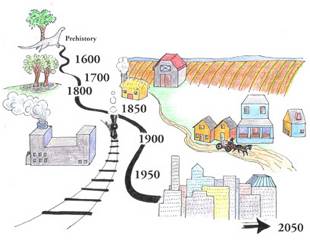
- Students develop an initial time line for their study site
- Student teams launch their investigations.
In this activity, students situate their study site in time. Understanding context is critical to science. The meaning of a phrase or sentence is influenced by the text that surrounds it. Scientists know the same is true for the objects they study. The history of civilization can be seen as a broadening of perspective, extending outwards from local, limited, and rural to regional and global. With recent discoveries by astronomers using orbiting telescopes and space probes, we can benefit from a truly planetary perspective.
After a introduction as a whole class to different ways to divide time, and the create of a basic time line, students can work in teams to investigate the various histories of their study site - it is a class-wide cooperative investigation. Each team can work towards the creation of a 15-minute presentation, including their own unique time line, and post their findings on their web site. Students across the community can read and review each other's work, as do communities of scientists and scholars. We suggest you organize the class into different student teams - and explain that each team is responsible for one part of the investigation. (If the team approach is not comfortable to you, you can work through several of the themes serially. Do as many teams as you feel able to "field.")
1. Discuss with your class:
- the value of "context."
What is meant when something is taken "out of context?" Might a word have a different sense in the context of different sentences? Might a sentence be less meaningful out of the context of a paragraph? Brainstorm with the class: What might be the "context" of your study site? How might that change from one time period to another? Imagine a similar study site set within a city park, and another set in the countryside. What difference would that make?
- change itself, and the signs that are left behind in the passage of history. Trees, for example, preserve their history in their rings, the width of which reflects available moisture and nutrients that year. Rock layers can reflect alterations of ocean and dry land as coastal areas changed. Deep patterns in land can reflect where sites of ancient buildings were located.
- time periods. What is a useful time division for human lifetime (e.g. decades)? For human history (fifty -hundreds of years) For archeological digs? (thousands of years) For geological periods? (thousands to millions of years)
2. Create a first rough timeline of the study site's history.
Ask your students: Did the study site always look as it does today? Who and what walked on their study site before you? Who were the first people to arrive at your study site? What are the earliest plant and animal records we have for the study site region? How have its animals and plants changed over time?
Have students work, either as a class or alone in their journals, to brainstorm major events in time that can serve as benchmarks on the Timeline. These might go back in time to include settlement times, even prehistoric ages.
3. Launch the research into critical periods in your study site history
Explain to students that their assignment is to research and describe some critical periods in the history of their study site, and place these on the class basic time line. They will work in teams organized by disciplines. Later they will present their work to their fellow students and to other classrooms on the web.
Teams can include:
- Geology Team - the geological history of the study site from the formation of the continent to the present. This class will be able to use the information from the Geology activity.
- Paleontology Team - the history of early life on Earth as recorded in fossils and other artifacts.
- Local History Team - the history of the local area, with emphasis on photographs and diaries.
- Archeology Team - the social (cultural and political history) from the arrival of the first people to the area to the present. This team might want to read the supplement, Toponymics, the study of the origins of place names.
- Physical Geography Team - the evolution of the local landscape and its human population; projecting the impact of population growth on the land.
Have students brainstorm sources of information that they might access: people, electronic resources, newspapers, magazines, books, maps, museums, local offices, and the Internet. Student reports can include photos, maps, sketches, paintings, and links to Web sites. Also remind them of the deadline for their reports.
Each team should expect to present, at the end of several weeks, a 15-minute presentation on their topic and create a poster of their findings including any relevant maps, sketches, timelines, photographs, or other graphics. Also emphasize that each team is contributing to the whole and that teams are not in competition with one another. Your Study Site in Time describes team responsibilities. Each team will also have resource pages and worksheets.
4. Help student teams conduct their investigations using multiple sources of information.
You can organize these next several weeks in different ways. Consider including:
- a field trip to a local museum
- an internet search class
- interviews of local experts
- a class on the nature of evidence. Encourage students to critically examine, verify, and cite their sources.